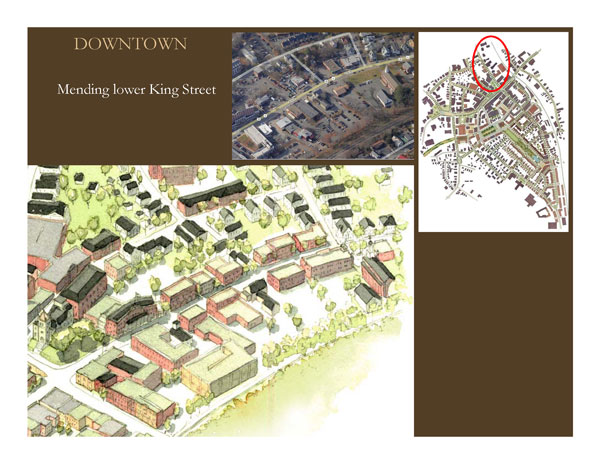Here is a complete blip.tv video of the 5/20/09 meeting of the Zoning Revisions Committee. This video is 1 hour 55 minutes long and was recorded by Ken Mitchell. The meeting includes a discussion of King Street and its long-standing struggles.
The agenda:
- Public comment
- Continue discussion of the web site
- Follow up on any open issues for the Green Building initiatives
- Review the prioritized list of zoning changes from the Planning Board
- Discuss possible inclusion/integration of Notre Dame Report Envisioning Sustainable Northampton
Video highlight:
1:30:09-1:38:39… Discussion of design guidelines. Jim Nash: Neighborhood groups have anxiety about what infill will look like. Specifying design guidelines up front will ease the way for other regulatory changes. Residents will have more trust in the outcome. Let’s analyze mistakes from the past.
DRAFT Sustainable Northampton Regulatory Implementation Table (download high-resolution JPEG, 864KB)

See also:
Audio Recording of Zoning Revisions Committee Meeting of 5/6/09
Video: Zoning Revisions Committee Meeting of 4/1/09; Wayne Feiden Gives Zoning Tutorial
Download Envisioning Sustainable Northampton – Final Notre Dame Studio Presentation Book
Envisioning Sustainable Northampton: Notre Dame Urban Design Presentation – Video and Handout
Envisioning Sustainable Northampton: Notre Dame Urban Design Presentation – Slides

Sustainable Northampton Plan
Our Ad in the May 6 Gazette: “How to Avoid Classic Infill Design Mistakes”
“For the past few decades,” write Knoxville area planners, “the construction of new houses on these vacant lots–infill housing–has often been incompatible with the historic features in neighborhoods of the late 1800’s to 1950’s. Inappropriate infill has been a problem in the ‘Heart of Knoxville’ neighborhoods…
“Following World War II, many single family neighborhoods were rezoned to permit apartments. This was done under an urban development theory that the highest density housing should be close to the central business district. The results have been mixed. In some instances the design of multi-unit buildings are completely out of context to older neighborhoods with apartment buildings looking like they should have been part of suburbia. In places where multi-unit housing is permitted…it is essential to neighborhood stability that new apartment buildings be designed in scale and context with the early architectural features of the neighborhood…”
Knoxville Infill Housing Design Guidelines: Lessons from Experience
Portland Infill Design Strategies: Best Practices for Context-Sensitive Infill Design
Toronto Urban Design Guidelines: Infill Townhouses
Smart Growth vs. “Smart Growth”
…developers often seize on convenient aspects of Smart Growth that align
with their profit goals and disregard others. A common result appears
to be overlarge developments, inapt developments, and/or excessive
density. These are major bones of contention in Los Angeles and Berkeley, to give two examples.
Video: Planning Board Reviews the Latest Kohl Condo Proposal on 5/14/09
Without an understanding of human nature, well-intended Smart Growth
policies can backfire, increasing sprawl. If planners want people to
live in downtown neighborhoods, they need to demonstrate those
neighborhoods will be respected, protected, and handled gently.
March 10: Zoning Revisions Committee to Meet; Our Suggestions
The Zoning Revisions Committee is charged with recommending zoning changes that implement the Sustainable Northampton Plan. We urge the committee to keep these considerations in mind:
- Before trying to facilitate infill development, might it be best to first establish infill design standards? (see Springfield)
- How can we encourage development within already paved-over spaces
as opposed to eating into greenspace? Why are spaces in certain in-town
areas like King Street languishing unused? Are there concerns about
hazardous waste that need to be addressed? - How will proposed rule changes affect the quality of life within
in-town districts? Changes that erode amenities (e.g. greenspace),
raise safety issues (e.g. more flooding) or create hassles (e.g. more traffic jams) may defeat the purpose of the Sustainable Northampton Plan by motivating homebuyers to sprawl out elsewhere…
Planners’ Assumptions about Future Household Size and Car Usage May Prove Wrong
Wall Street Journal: “How Group Decisions End Up Wrong-Footed”
[Wall Street Journal:] For committees and other boards to work well, they must be made up of
people with differing perspectives and experience who are unafraid to
speak their minds, says Richard Larrick, a psychologist at Duke
University’s Fuqua School of Business. They must also select and
process information effectively and seek to learn systematically from
their mistakes.
With respect to local urban planning, developments that have been
plagued with problems need to be analyzed so the Planning Board and
Conservation Commission can make more informed decisions going forward.
Good candidates for study include Meadowbrook Apartments, homes on Winslow, Nutting and Elm Streets, and the stormwater management systems at Northampton High School, Carlon Drive, and Bridge Street School. Violations of existing wetlands protection agreements are rampant, according to Land Use and Conservation Planner Bruce Young. Before signing off on more aggressive developments and complex convenants, it’s time for city boards to step back and understand what’s causing these unsatisfactory situations.
Greater
awareness of past experience might also help balance the temptation to
embrace the latest fads, such as infill and Smart Growth. These
concepts have their merits, but there have been some troubled applications. Here we can tap hard-won knowledge from other cities to avoid repeating their mistakes.